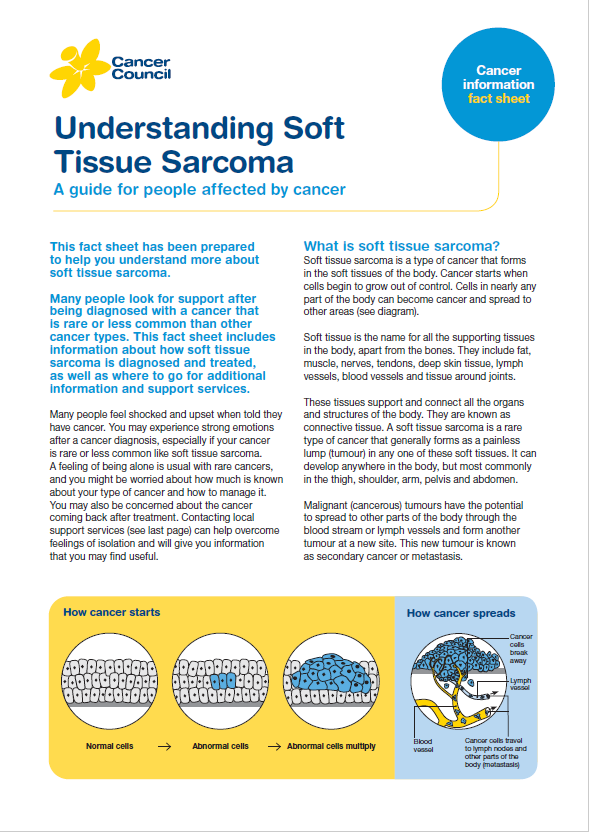- Home
- Soft tissue sarcoma
- Diagnosis
Soft tissue sarcoma diagnosis
If your doctor thinks that you may have a soft tissue sarcoma, they will take your medical history, perform a physical examination (including feeling any lumps) and carry out certain tests. These tests are needed to rule out other conditions.
If the results suggest that you may have sarcoma, your doctor will refer you to a specialist who will carry out more tests.
These may include:
| Biopsy | Removal of some tissue from the affected area for examination under a microscope. The biopsy may be done in one of two ways. In a core needle biopsy, a local anaesthetic is used to numb the area, then a thin needle is inserted into the tumour under ultrasound or CT guidance. An open or surgical biopsy is done under general anaesthesia. The surgeon will cut through the skin to expose the affected area and take a tissue sample. |
| Blood tests | Including a full blood count to measure your white blood cells, red blood cells and platelets. |
| X-rays | A painless scan of your chest to check your lungs for signs of cancer. |
| CT (computerised tomography) or MRI (magnetic resonance imaging) scans | Special machines are used to scan and create pictures of the inside of your body. Before the scan you may have an injection of dye (called contrast) into one of your veins, which makes the pictures clearer. During the scan, you will need to lie still on an examination table. For a CT scan the table moves in and out of the scanner which is large and round like a doughnut; the scan itself takes about 10 minutes. For an MRI scan the table slides into a large metal tube that is open at both ends; the scan takes a little longer, about 30–90 minutes to perform. Both scans are painless. |
| PET (positron emission tomography) scan | Before the scan you will be injected with a small amount of radioactive glucose (sugar) solution. Many cancer cells will show up brighter on the scan. You will be asked to sit quietly for around 30–90 minutes to allow the glucose to move around your body, and the scan itself will take around 30 minutes to perform. |
A biopsy is the only sure way to diagnose a soft tissue sarcoma and should only be carried out by a specialist who does them regularly and has special expertise in the area of sarcoma. It is important that the biopsy is done properly, to reduce the chance of the cancer spreading. It could also affect the type of treatment that you may be able to have.
Finding a sarcoma specialist
The Australia and New Zealand Sarcoma Association (ANZSA) can be contacted for a directory of specialists in sarcoma care and treatment.
Rare Cancers Australia have a directory of health professionals and cancer services across Australia.
→ READ MORE: Treating soft tissue sarcoma
Podcast: Tests and Cancer
Listen to more episodes of our podcast for people affected by cancer
More resources
Dr Susie Bae, Medical Oncologist, Peter MacCallum Cancer Centre, VIC; Tony Bice, Consumer; Dr Denise Caruso, CEO Australian and New Zealand Sarcoma Association, VIC; Emma Gardner, Nurse Coordinator, Bone and Soft Tissue Unit, Peter MacCallum Cancer Centre, VIC; Jonathan Granek, Consumer; Thelma Lobb, Consumer.
View the Cancer Council NSW editorial policy.
Need to talk?
Support services
Coping with cancer?
Speak to a health professional or to someone who has been there, or find a support group or forum
Need legal and financial assistance?
Pro bono services, financial and legal assistance, and no interest loans
Cancer information
What is cancer?
How cancer starts and spreads
Resource hub
Guides, fact sheets, videos, podcasts and more for people with cancer, their families and friends

